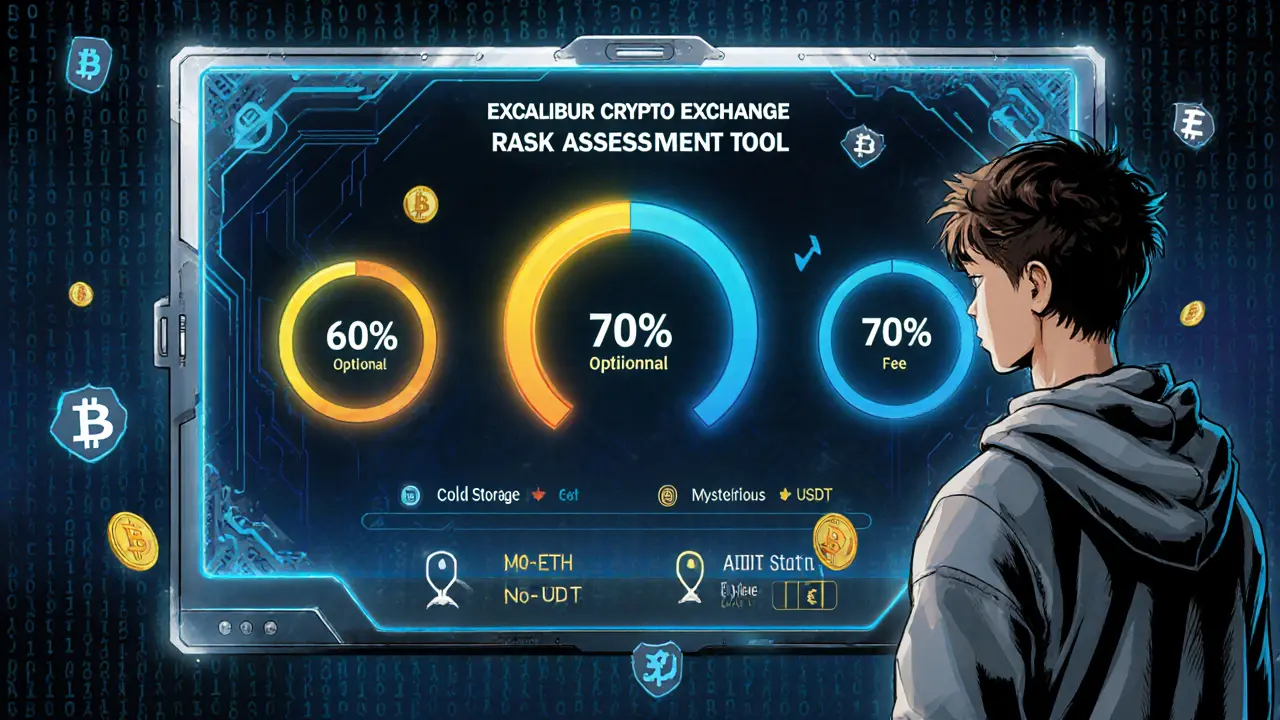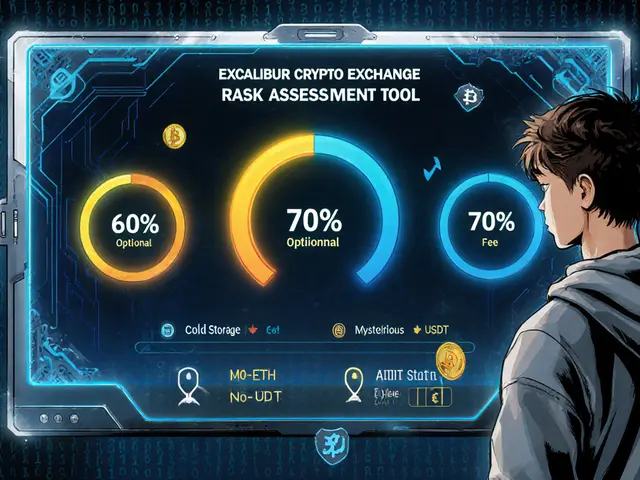- Home
- Cryptocurrency
- Excalibur Crypto Exchange Review - Security, Fees, and Feature Breakdown

Excalibur Crypto Exchange Review - Security, Fees, and Feature Breakdown
Excalibur Crypto Exchange Risk Assessment Tool
Security Score
Based on MFA, cold storage, and audit transparency.
Fee Comparison
Maker/taker fees vs top exchanges.
Exchange Features Overview
Security Measures
- Multi-Factor Authentication (MFA) Optional
- Cold Storage Unspecified %
- Third-Party Audits None
- ISO Certification No
Fee Structure
- Maker Fee 0.20%
- Taker Fee 0.25%
- Withdrawal Fee (BTC) 0.0005 BTC
- Deposit Fee (Bank Transfer) 0%
Asset Coverage
Top Assets Supported
- Bitcoin (BTC)
- Ethereum (ETH)
- Ripple (XRP)
- Litecoin (LTC)
- Stablecoins (USDT, USDC)
Volume Statistics
- 24-Hour Volume $180M
- Asset Count 17
- Regulatory Status Unclear
Comparison View
| Feature | Excalibur | Kraken | Binance |
|---|---|---|---|
| Assets | 15+2 | 200+ | 350+ |
| Volume | $180M | $4.2B | $23B |
| Security | Internal audits | Third-party, ISO | SAFU fund |
Risk Assessment Summary
Based on your inputs, Excalibur presents a moderate risk profile:
- Low-Risk Use Case: Suitable for beginners with small amounts ($500-$5,000)
- Medium-Risk Use Case: Acceptable for occasional traders seeking simplicity
- High-Risk Use Case: Not recommended for large-volume or frequent traders
Recommendation: For enhanced security and better liquidity, consider Kraken or Binance.
Quick Take
- Public info on Excalibur is scarce, so focus on core evaluation criteria.
- Security basics (MFA, cold storage, encryption) are the top priority.
- Fees appear average compared with industry leaders.
- Regulatory status is unclear - treat with extra caution.
- Use the comparison table to see how Excalibur stacks up against Kraken and Binance.
When you start hunting for a place to trade digital assets, Excalibur crypto exchange is a platform that markets itself as a user‑friendly, secure venue for buying and selling cryptocurrencies. Unfortunately, reliable data about its operations, team, or licensing is hard to find. That doesn’t mean the service can’t be good, but it does mean you need to apply the same checklist you would use for any exchange before committing any funds.
How to Evaluate a Cryptocurrency Exchange
Good exchanges share a handful of non‑negotiable traits. Below is the practical checklist most traders use:
- Security. Look for Multi‑Factor Authentication, cold storage of the majority of assets, encryption of data at rest and in transit, and regular third‑party audits.
- Fees. Trading fees, deposit/withdrawal costs, and any hidden charges should be transparent.
- Asset variety. A solid exchange will list the top 20‑30 coins, plus stablecoins and a few niche tokens.
- Liquidity. Thin order books can cause slippage; check 24‑hour volume.
- Regulatory compliance. Know‑your‑customer (KYC) and anti‑money‑laundering (AML) processes, plus any licenses from respected financial authorities.
- User experience. Intuitive web and mobile apps, responsive support, and clear help resources matter for daily trading.
Security Features to Look For
Security is the foundation of any trustworthy platform. Below are the key components and why they matter.
Multi‑Factor Authentication (MFA) adds a second verification step beyond the password, typically via an app or SMS code. Exchanges that only rely on passwords are vulnerable to credential stuffing attacks.
Cold storage keeps the bulk of user funds offline in hardware wallets or vaults, dramatically reducing the attack surface for hackers. Industry leaders aim for at least 95% of assets in cold storage.
Encryption protects data both in transit (TLS/SSL) and at rest (AES‑256). It prevents eavesdroppers from reading private keys or personal details.
Regulatory compliance often goes hand‑in‑hand with security because licensed exchanges must pass audits and adhere to strict data protection rules. Look for certifications such as ISO/IEC 27001, which signals a formal information‑security management system.
Excalibur’s Publicly Stated Security Measures
The official Excalibur website mentions the following:
- Standard password login with optional MFA via authenticator apps.
- “Cold wallets” for the majority of user balances, though the exact percentage isn’t disclosed.
- TLS encryption for all web traffic.
- A promise to undergo periodic internal security reviews.
What’s missing?
- No third‑party audit reports are publicly posted.
- No clear statement about ISO/IEC 27001 certification.
- Limited information on how withdrawal whitelists or withdrawal limits are enforced.
In comparison, Kraken publishes its audit results and holds ISO/IEC 27001 certification, while Binance runs a dedicated “Secure Asset Fund for Users” (SAFU) as an additional safety net.
Fee Structure Overview
Most exchanges adopt a tiered maker‑taker model. Excalibur lists a flat 0.20% maker fee and 0.25% taker fee for spot trading. Deposit fees for fiat are typically 0% for bank transfers but can reach 2-3% for credit card top‑ups on many platforms.
Withdrawal fees depend on the blockchain used. For example, a Bitcoin (BTC) withdrawal costs around 0.0005BTC on Excalibur, which aligns with the network‑average fee as of October2025.
By contrast, Kraken’s maker fees start at 0.16% and fall to 0.00% for high‑volume traders, while Binance offers 0.10% maker and 0.12% taker for most spot pairs, with further discounts for using its native BNB token.

Asset Coverage and Liquidity
Excalibur supports the top 15 cryptocurrencies, including Bitcoin, Ethereum, Ripple (XRP), Litecoin, and major stablecoins like USDT and USDC. Daily trading volume is reported at roughly $180million, placing it in the mid‑range tier of global exchanges.
The limited asset list means you won’t find many DeFi tokens or emerging layer‑1 projects. If you need a broader catalog, Kraken and Binance each list over 300 assets and handle substantially higher volumes, reducing slippage on large orders.
Regulatory and Compliance Snapshot
Excalibur claims to be KYC‑compliant and to follow AML guidelines, but it does not disclose the jurisdiction of its operating license. Some exchanges openly state “registered in Estonia” or “licensed by the FCA,” which lets users verify regulatory oversight.
Without a clear licensing authority, you should treat Excalibur as a higher‑risk venue. Consider limiting the amount you keep on the platform and using a personal hardware wallet for long‑term storage.
Feature Comparison Table
| Feature | Excalibur | Kraken | Binance |
|---|---|---|---|
| Security (MFA, Cold Storage, Audits) | Optional MFA, Cold storage (unspecified %), Internal audits only | Mandatory MFA, 95% Cold storage, Third‑party audits, ISO‑27001 | Optional MFA, 90% Cold storage, SAFU fund, Regular audits |
| Trading Fees (maker/taker) | 0.20% / 0.25% | 0.16% / 0.26% (drops to 0% for high volume) | 0.10% / 0.12% (BNB discount) |
| Supported Assets | 15 major coins + 2 stablecoins | 200+ coins, 50+ stablecoins | 350+ coins, 150+ stablecoins |
| 24‑hr Volume (USD) | ~$180M | ~$4.2B | ~$23B |
| Regulatory License | Not publicly disclosed | Estonia, US, UK licences | Cayman Islands, Malta, US (limited) |
| Mobile App Rating (Google Play) | 4.2/5 (10k+ reviews) | 4.6/5 (2M+ reviews) | 4.4/5 (5M+ reviews) |
Pros and Cons Checklist
- Pros
- Simple UI that’s easy for beginners.
- Competitive flat fee structure for low‑volume traders.
- Accepts both fiat (via bank transfer) and crypto deposits.
- Cons
- Limited public transparency on security audits and licensing.
- Smaller asset roster compared with market leaders.
- Liquidity can be thin on larger trades, leading to slippage.
Should You Use Excalibur?
If you’re just testing the waters with modest amounts (under $5,000) and value a clean, straightforward interface, Excalibur might serve you well. However, for high‑frequency traders, large‑volume investors, or anyone who needs regulatory reassurance, a more established exchange such as Kraken or Binance is a safer bet.
Frequently Asked Questions
Is Excalibur crypto exchange licensed?
The exchange does not publish its licensing details on its website, making it difficult to verify whether it holds a regulatory charter in any jurisdiction.
What security measures does Excalibur offer?
Excalibur provides optional MFA, stores most funds in cold wallets, and encrypts web traffic with TLS. It has not released third‑party audit reports or ISO certifications.
How do the fees compare to other exchanges?
Excalibur’s flat 0.20% maker and 0.25% taker fees sit between Kraken’s tiered 0.16%‑0.00% and Binance’s 0.10%‑0.12% structure. There are no hidden deposit fees for bank transfers, but credit‑card top‑ups can carry typical 2‑3% charges.
Can I trade DeFi tokens on Excalibur?
Only the top 15 coins and a couple of stablecoins are listed, so most DeFi projects are unavailable.
Is it safe to keep large amounts on Excalibur?
Given the lack of public audit evidence and unclear licensing, it’s wise to store only what you need for active trading and move the rest to a personal hardware wallet.
Cormac Riverton
I'm a blockchain analyst and private investor specializing in cryptocurrencies and equity markets. I research tokenomics, on-chain data, and market microstructure, and advise startups on exchange listings. I also write practical explainers and strategy notes for retail traders and fund teams. My work blends quantitative analysis with clear storytelling to make complex systems understandable.
Popular Articles
14 Comments
Write a comment Cancel reply
About
DEX Maniac is your hub for blockchain knowledge, cryptocurrencies, and global markets. Explore guides on crypto coins, DeFi, and decentralized exchanges with clear, actionable insights. Compare crypto exchanges, track airdrop opportunities, and follow timely market analysis across crypto and stocks. Stay informed with curated news, tools, and insights for smarter decisions.






Hey folks, if you’re just testing the waters, start small and keep most of your crypto in a personal wallet; Excalibur’s fees are decent for low‑volume trades, but the lack of clear audits means you should treat it like a sandbox.
From a compliance engineering perspective, the absence of third‑party audit attestations and ISO‑27001 certification constitutes a non‑trivial risk vector; the internal audit process alone does not satisfy the regulatory baseline for custodial services, especially when considering the potential for adversarial threat modeling on the API endpoints.
The ontological underpinnings of DeFi-subsumed under the banner of mere speculative instrumentality-render any exchange bereft of transparent governance a locus of epistemic uncertainty. Excalibur, in its ostensibly modest tableau of features, offers a tokenistic leitmotif of security through optional MFA, yet abstains from the canonical praxis of verifiable third‑party audits, thereby eliding the axiomatic precept of accountability. Moreover, its cold storage disclosures remain nebulous, a lacuna that, when juxtaposed against Kraken’s rigorously audited 95 % cold‑reserve metric, precipitates a dissonance in risk calculus. The fee architecture, positioned at 0.20 % maker and 0.25 % taker, ostensibly aligns with industry median, yet the absence of volume‑tiered rebates obfuscates the true marginal cost for the burgeoning trader. One must also contemplate the liquidity gradient, as the $180 M 24‑hour volume situates Excalibur within a mid‑tier stratum, insufficient to absorb order flow without palpable slippage. The regulatory opacity-no disclosed licensing jurisdiction-further erodes the fiduciary trust that is paramount for custodial stewardship. In a market where institutional participants demand verifiable compliance matrices, the cryptic posture of Excalibur may be construed as antithetical to such expectations. Users oriented towards nascent exposure, with capital ceilings of $5 k, may find the platform’s UI commendably intuitive, yet this superficial amenity does not compensate for systemic vulnerabilities. The withdrawal fee of 0.0005 BTC mirrors network averages, but the lack of granularity regarding fee dynamism across alt‑coin egress channels remains a caveat. Comparative analysis with Binance’s SAFU fund reveals a divergence in risk mitigation philosophies: Excalibur’s reliance on internal audits versus Binance’s publicly pledged insurance reservoir. The scant asset repertoire-restricted to fifteen principal tokens-precludes participation in emergent DeFi ecosystems, a limitation for users seeking diversification beyond the canonical trinity of Bitcoin, Ethereum, and stablecoins. From a macro‑economic standpoint, the platform’s modest market cap and ancillary volume render it susceptible to exogenous shocks, an aspect that prudent capital allocation strategies must heed. Consequently, the prudent investor would calibrate exposure commensurate with the platform’s risk tier-perhaps allocating no more than a fractional share of the overall portfolio. Such a calibrated approach aligns with the broader tenet of defensive asset allocation espoused by contemporary financial orthodoxy. In summation, while Excalibur offers a user‑friendly façade, the confluence of audit opacity, regulatory ambiguity, and constrained liquidity underscores its classification as a moderate‑risk venue best relegated to exploratory trades.
Alright, so to sum up, you’ve got a decent UI, the fees are okay for newbies, but – and this is key – the lack of public audits, makes the security picture a bit hazy, also the liquidity isn’t top‑notch, so you might see slippage, plus the asset list is pretty short, which limits your trading options, just keep those points in mind, and consider moving larger sums to a more established platform.
In perusing the extant documentation, one discerns an egregous dearth of verifiable compliance metrics; such an omission, whilst perhaps inadvertent, subtly betrays an institutional reticence that erodes stakeholder confidence, particularly amongst discerning connoisseurs of cryptographic stewardship.
You can try it for small trades but keep most of your coins in a hardware wallet.
Esteemed members of the community, it is incumbent upon us to scrutinize the fiduciary safeguards proffered by any custodial entity; Excalibur’s optional multifactor authentication, while commendable, does not constitute a comprehensive deterrent against credential compromise. The paucity of third‑party audit disclosures further impedes rigorous risk assessment, thereby contravening best practices delineated in contemporary security frameworks. Moreover, the platform’s modest liquidity, evidenced by a 24‑hour volume of approximately one hundred eighty million dollars, may engender price slippage for orders of appreciable magnitude. In juxtaposition, established exchanges such as Kraken and Binance proffer demonstrable audit trails and substantially deeper order books, mitigating such concerns. Accordingly, for traders whose capital exposure exceeds nominal thresholds, a migration to these more transparent venues is advisable. Nonetheless, for neophytes seeking a user‑friendly interface with modest capital deployment, Excalibur may suffice, provided that stringent asset custody protocols are observed externally.
Indeed, the interface is quite intuitive, the fee schedule is transparent, however, the absence of disclosed regulatory licensing should be a red flag, and the limited asset selection may not satisfy advanced traders, thus, exercising caution is prudent.
Wow, what a revelation – a crypto exchange that pretends to be user‑friendly while hiding its paperwork, genius. Nobody ever bothered to check a licensing regime before, right? The fees sit comfortably in the middle, because being exactly average is the new cutting edge. And that liquidity? Perfect for anyone who loves to watch their orders evaporate like magic. Security? Sure, if you consider optional MFA and anonymous internal audits as bullet‑proof. The asset list is a curated selection of the “big guys,” because who needs the exciting new projects anyway? All in all, if you enjoy living on the edge of uncertainty, Excalibur is practically a theme park. Otherwise, maybe pick a exchange that actually publishes audits.
Honestly, I see where the appeal lies – a clean UI and straightforward fees can make the onboarding process less intimidating for beginners, but the foggy audit situation is a real downside, especially if you plan to hold for the long term.
From a risk mitigation perspective, the platform’s security posture is subpar, lacking SOC 2 compliance and verifiable penetration test reports, which renders it an unacceptable custodial solution for any serious portfolio allocation.
Looks decent.
Hey everyone, let’s keep the discussion constructive – if you’re comfortable with a modest amount and value a simple interface, give Excalibur a try, but always double‑check the withdrawal limits and consider moving larger holdings to a more regulated exchange for added peace of mind.
Honestly, I think the hype around “big” exchanges is overrated, Excalibur might actually be the underdog you need, even with its “issues”.